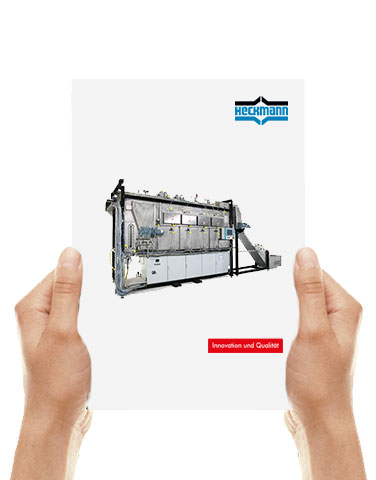
SHS DRYING
Drying is an essential process step in many industrial sectors. The usual process, which is operated with hot air, mostly has a very high energy consumption throughout the entire processing chain. Due to decreasing resources and rising prices, the demand for drying processes with significantly lower energy requirements is increasing. Due to this, there is a need for optimisation with regard to the drying processes to be used, but of course also with regard to the process engineering plants. Drying with superheated steam (SHS) at atmospheric pressure offers advantages over conventional drying with hot air. Together with Fraunhofer IGB, this drying process has been continuously further developed and is now used in numerous plants.
Further advantages can be found in section 1.2.
1.1 Comparison of the procedure with the state of the art
The drying process is based on the apparatus design of the well-known continuous drying process using hot air. The product is introduced via a gas-tight product inlet in accordance with the specified throughput rate. In the dryer the product is moved from the inlet to the outlet and intensively circulated and loosened by the hot gas stream. In contrast to the known drying processes, however, here the hot air is completely replaced by a superheated water vapour stream, which is constantly moved by means of a fan in the dryer. The dryer is almost oxygen-free during operation. A fire or explosion hazard is thus practically excluded. A heater in the drying system heats the steam flow to the desired drying temperature again and again. The systems can be equipped with heat exchangers that are heated by means of heating steam, thermal oil or flue gas. In addition, we offer heating with quality burners from renowned manufacturers, which guarantee low emission values and long-term and safe operation. The burners can be operated with the following heat carriers: light and heavy fuel oil, natural gas, liquid gas, biodiesel or biogas.
As a result of the intensive contact of the product with the superheated steam flow, the heat transfer is very good. The product heats up, causing the water to evaporate. The amount of superheated steam has increased by the volatile components, its temperature has dropped according to the heat emission to the product during drying. Via a branch pipe in the system, the quantity of hot gas that has reached the hot steam flow during the drying process can be circulated out. The heat extracted from the circulated gas stream condenses the water vapour and the aroma and odour substances it contains.
Please contact us for further information: André Nitzsche, Tel.: 0421-41090-53, E-Mail: andre.nitzsche@heckmann-mt.de
You can find out more about the principle of hot steam drying on the website of our partner: Fraunhofer IGB.
1.2 Comparison of the procedure with the state of the art
The use of superheated steam as drying gas results in the following essential differences to a conventional drying process which is operated with hot air.
Water vapour has a specific heat capacity almost twice as high as that of air and thus contains twice the amount of heat for specific masses. Due to the lower density and viscosity of water vapour compared to air, a lower mass flow is moved through the system with the same volume flow. Considering all physical properties, a hot steam flow under the same process conditions contains approx. 30 % more energy than an air flow. As a result, the hot steam flow during the drying process cools down less compared to air, resulting in improved heat transfer conditions and shorter drying times. The energy content of the gas stream coming from the dryer can again be fully used for the process. In this case, the water vapour flow only has to be heated from its outlet temperature back to the inlet temperature into the dryer. This means that a considerable amount of thermal energy can be saved during drying. With this operating mode, the exhaust gas flow is reduced to the technologically possible minimum. All in all, only as much excess steam needs to be circulated out of the process as gas is generated during drying. The water vapour can be condensed almost completely from the excess gas and is thus produced as a waste water stream. It can therefore be used sensibly for other processes in the production chain. The exhaust gas flow is several times smaller than with hot air drying, depending on the mode of operation.
The use of steam means that an inert phase (i.e. oxygen-free gas) is used in the drying process. In contrast to air operation, there is no danger of fire or explosion. Therefore, the corresponding cost-intensive protective measures of the process can be completely dispensed with here. By using the inert phase, a negative influence on the material to be dried due to oxidation processes is also avoided. A better product quality can be the result.
In their interaction, these essential differences in the use of superheated steam compared to hot air are so significant that, despite a similar design of the process, a completely new mode of operation emerges, which has clear overall advantages over the drying process using hot air.
Process comparison
- Significant reduction of the thermal energy requirement for the drying process
- Reduction of the exhaust gas flow
- Explosion and fire hazard is greatly minimised, as no oxygen is present in the system.
- Simplification of the process (shorter drying times, no explosion and fire protection)
- Gentle product drying (no oxidation processes)
- Recovery of the flavouring substances and the water contained in the product,
- Odour emissions are greatly minimised
1.3 Pilot plant
Our new pilot plant is your link between idea, concept and realisation. With our laboratory machines, planned drying processes can be tested, documented and proven. Here we test our developments and offer our customers from many areas of industry a wide range of services. With its special drying behaviour, your product determines the design and adaptation of the dryer. Our engineers and technicians calculate and determine the right solution in practical tests. For tests in the pilot plant we charge a daily rate which is credited back to the customer when the order is placed.
Verifiable parameters
- Feasibility study
- Scale-up for future production machines
- pH values
- Residual moisture
- Process times
- Drying behaviour
- Energetic and product-related process comparison between air and superheated steam
- Measurement of the energy demand at all test dryers
- Integration of drying into existing processes
- Product change during the drying process
- Determination of the appropriate drying method
1.3.1 Laboratory dryer
The portable air and SHS laboratory dryer has been specially developed to dry a wide range of products with air and superheated steam and to determine the energy and quality differences. The laboratory dryer is designed exclusively as a semi-technical pilot plant and is not performance-oriented.
In this plant, the process technology is separated from the product chamber. This has the advantage of individual adaptation of the drying chamber and conveyor technology to the respective product. Two drying chambers are available for the different applications, which can be exchanged with a few hand movements if required.
1. Coarse and fine-grained granulates can be dried in the vortex chamber in continuous operation.
2. In the fluid bed chamber, products can be dried in batch operation up to a maximum size of 400mm x 400mm x 200mm.

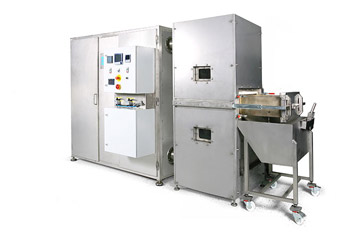
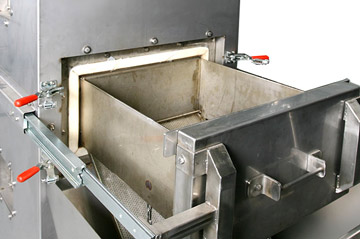
1.3.2 SHS belt dryers
The SHS test belt dryer reproduces, on a smaller scale, the function of a continuous belt dryer. The SHS belt dryer was developed together with Fraunhofer IGB and is a continuous convection dryer. The product to be dried is conveyed through the dryer housing on a stainless steel belt through which superheated steam flows during this time. It has four drying zones that can be controlled independently of each other. Parameters such as residence time, temperature, flow velocities etc. can be set individually for each product.

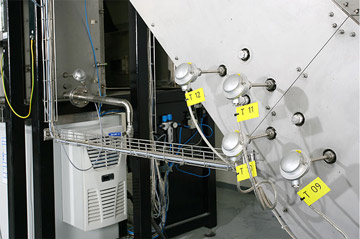
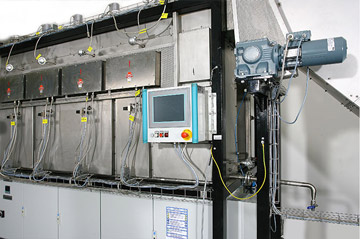
1.3.3 SHS vibration fluid bed dryers
The vibrating fluid bed dryer / roaster is designed as a free-swinging system with double vibration motor drive. The machine is mounted on a frame with elastic springs and the exciter is located directly below the machine. The advantage of a cantilever is the control of the speed via a frequency converter and thus a variable adjustment of the residence time of the product in the drying chamber/vibrating chute.
The product is fed into the dryer via a screw, for example. In the invertebrate channel of the dryer, the product is intensively circulated from the inlet to the outlet and slightly swirled by the hot gas stream. The inflow is divided into four zones. For roasting coffee and cocoa beans, for example, a quenching and cooling zone is located behind the dryer.
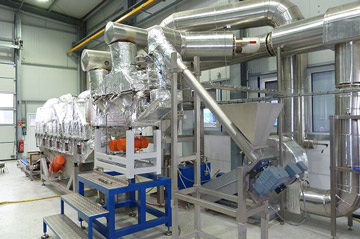
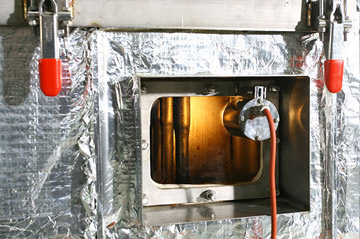
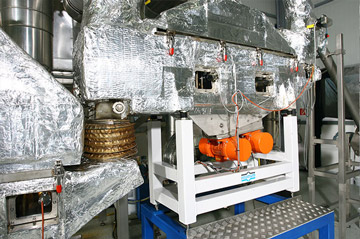
1.3.4 SHS grinding dryer
During grinding drying, the gas flow is sucked out of the heating coil and conveyed through the mill. During comminution, the product is also dried there using the hot gas stream. The dried material particles are discharged from the mill with the superheated steam, pneumatically conveyed via a pipeline to the cyclone and fabric filter and separated from the gas stream there.
The product is captured in the steam flow, subjected to extreme turbulence and crushed by the impact of particles on particles and on grinding paths and tools. The grinding of explosive products can be realized by the superheated steam atmosphere. The vortex mill can also be used for sticky, pasty or temperature-sensitive products.
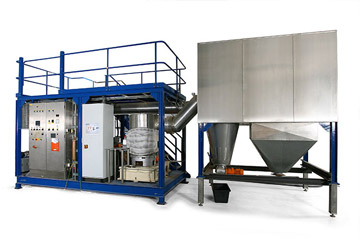
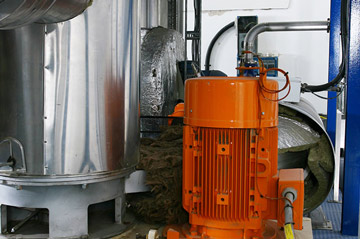
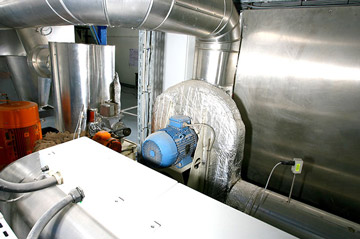
1.4 Range of services
- Consulting, assessment, investigation for drying
- Tests with one of our pilot plants
- Product-related evaluation of the drying process
- Process design
- Numerical simulation of flow, heat transfer
- Development of an individual plant concept
- Design specification with 3-D CAD
- Manufacturing, assembly and testing of the system
- Commissioning of the plant at our customer’s site
- Accompaniment of our customers from the very first preliminary examination


